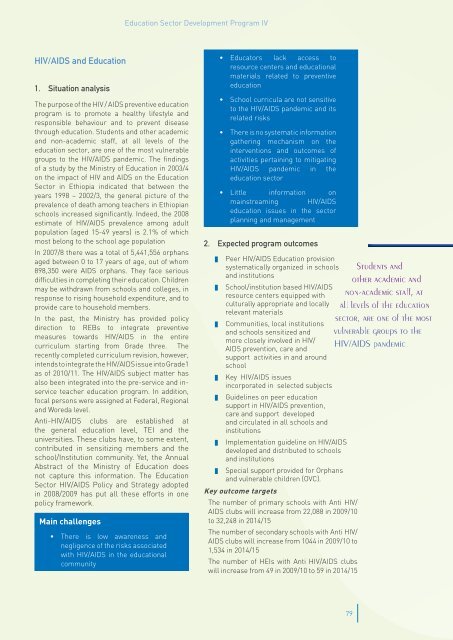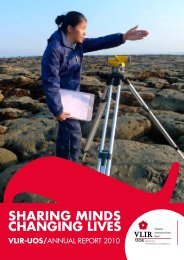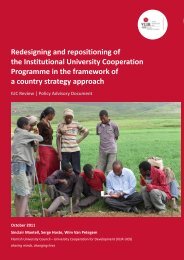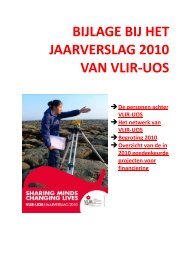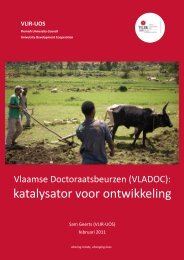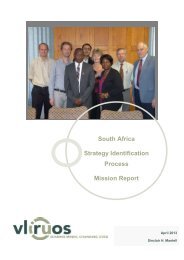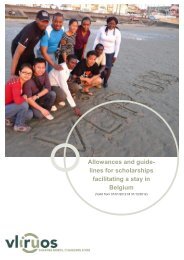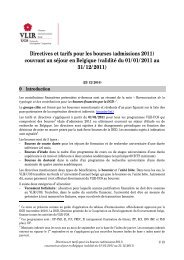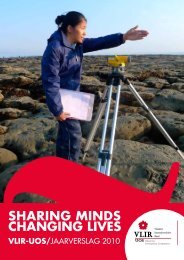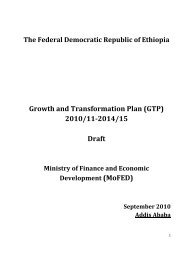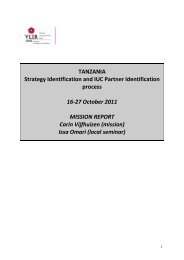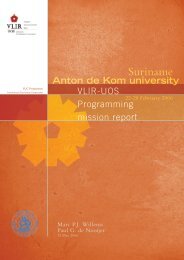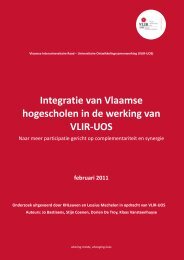Education Sector Development Program - VLIR-UOS
Education Sector Development Program - VLIR-UOS
Education Sector Development Program - VLIR-UOS
You also want an ePaper? Increase the reach of your titles
YUMPU automatically turns print PDFs into web optimized ePapers that Google loves.
<strong>Education</strong> <strong>Sector</strong> <strong>Development</strong> <strong>Program</strong> IV<br />
HIV/AIDS and <strong>Education</strong><br />
1. Situation analysis<br />
The purpose of the HIV / AIDS preventive education<br />
program is to promote a healthy lifestyle and<br />
responsible behaviour and to prevent disease<br />
through education. Students and other academic<br />
and non-academic staff, at all levels of the<br />
education sector, are one of the most vulnerable<br />
groups to the HIV/AIDS pandemic. The findings<br />
of a study by the Ministry of <strong>Education</strong> in 2003/4<br />
on the impact of HIV and AIDS on the <strong>Education</strong><br />
<strong>Sector</strong> in Ethiopia indicated that between the<br />
years 1998 – 2002/3, the general picture of the<br />
prevalence of death among teachers in Ethiopian<br />
schools increased significantly. Indeed, the 2008<br />
estimate of HIV/AIDS prevalence among adult<br />
population (aged 15-49 years) is 2.1% of which<br />
most belong to the school age population<br />
In 2007/8 there was a total of 5,441,556 orphans<br />
aged between 0 to 17 years of age, out of whom<br />
898,350 were AIDS orphans. They face serious<br />
difficulties in completing their education. Children<br />
may be withdrawn from schools and colleges, in<br />
response to rising household expenditure, and to<br />
provide care to household members.<br />
In the past, the Ministry has provided policy<br />
direction to REBs to integrate preventive<br />
measures towards HIV/AIDS in the entire<br />
curriculum starting from Grade three. The<br />
recently completed curriculum revision, however,<br />
intends to integrate the HIV/AIDS issue into Grade1<br />
as of 2010/11. The HIV/AIDS subject matter has<br />
also been integrated into the pre-service and inservice<br />
teacher education program. In addition,<br />
focal persons were assigned at Federal, Regional<br />
and Woreda level.<br />
Anti-HIV/AIDS clubs are established at<br />
the general education level, TEI and the<br />
universities. These clubs have, to some extent,<br />
contributed in sensitizing members and the<br />
school/Institution community. Yet, the Annual<br />
Abstract of the Ministry of <strong>Education</strong> does<br />
not capture this information. The <strong>Education</strong><br />
<strong>Sector</strong> HIV/AIDS Policy and Strategy adopted<br />
in 2008/2009 has put all these efforts in one<br />
policy framework.<br />
Main challenges<br />
• There is low awareness and<br />
negligence of the risks associated<br />
with HIV/AIDS in the educational<br />
community<br />
• Educators lack access to<br />
resource centers and educational<br />
materials related to preventive<br />
education<br />
• School curricula are not sensitive<br />
to the HIV/AIDS pandemic and its<br />
related risks<br />
• There is no systematic information<br />
gathering mechanism on the<br />
interventions and outcomes of<br />
activities pertaining to mitigating<br />
HIV/AIDS pandemic in the<br />
education sector<br />
• Little information on<br />
mainstreaming HIV/AIDS<br />
education issues in the sector<br />
planning and management<br />
2. Expected program outcomes<br />
❚<br />
❚<br />
❚<br />
❚<br />
❚<br />
❚<br />
❚<br />
Peer HIV/AIDS <strong>Education</strong> provision<br />
systematically organized in schools<br />
and institutions<br />
School/institution based HIV/AIDS<br />
resource centers equipped with<br />
culturally appropriate and locally<br />
relevant materials<br />
Communities, local institutions<br />
and schools sensitized and<br />
more closely involved in HIV/<br />
AIDS prevention, care and<br />
support activities in and around<br />
school<br />
Key HIV/AIDS issues<br />
incorporated in selected subjects<br />
Guidelines on peer education<br />
support in HIV/AIDS prevention,<br />
care and support developed<br />
and circulated in all schools and<br />
institutions<br />
Implementation guideline on HIV/AIDS<br />
developed and distributed to schools<br />
and institutions<br />
Special support provided for Orphans<br />
and vulnerable children (OVC).<br />
Key outcome targets<br />
The number of primary schools with Anti HIV/<br />
AIDS clubs will increase from 22,088 in 2009/10<br />
to 32,248 in 2014/15<br />
The number of secondary schools with Anti HIV/<br />
AIDS clubs will increase from 1044 in 2009/10 to<br />
1,534 in 2014/15<br />
The number of HEIs with Anti HIV/AIDS clubs<br />
will increase from 49 in 2009/10 to 59 in 2014/15<br />
Students and<br />
other academic and<br />
non-academic staff, at<br />
all levels of the education<br />
sector, are one of the most<br />
vulnerable groups to the<br />
HIV/AIDS pandemic.<br />
79


